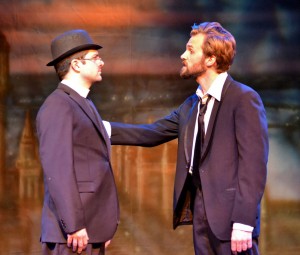Father Brown creates dynamic who-done-it mystery
On the surface, the detective play The Innocence of Father Brown seems like it would follow the formulaic “cat and mouse” plot. Instead, the production, which premiered March 30 at the Fremont Centre Theatre in South Pasadena, turns the who-done-it into a fine-tuned examination of justice, religion, reason, truth and guilt.

Sleuthing · Blake Walker (left) who plays the detective-priest Father Brown and Brandon Parrish (right) who plays Flambeau, stumble through a story of mystery and intrigue as they try to catch a criminal in Father Brown. – Courtesy of Ellie Roth
Originally brought to life in a volume of 12 stories written by G.K. Chesterton in 1911, Father Brown, at first glance, appears to be a harmless priest living in London, but his powers of deductive reasoning bring to mind the master of mystery, Sherlock Holmes.
Though Holmes is an aloof and eccentric character — seemingly too smart for the lowly plebeians that make up society — Father Brown regards humanity with great interest and humility (his unpretentious bowler hat and spectacles even serve as the outward manifestation of his modesty).
Playwright Patrick Rieger’s adaptation stays faithful to the core of Chesterton’s stories, delivering plot twists and accusations that serve as a way for the audience to re-examine the crime and who the culprit could be. Chesterton and Rieger, however, offer the audience a deeper layer than many stories of this genre; the more the audience attempts to follow Father Brown’s thought process and make astute observations trying to deduce who-done-it, the more they also begin to recognize the deeper messages that Chesterton is trying to convey.
The Innocence of Father Brown is aptly titled, as it is this innocence that is called into question throughout the entire play.
At one point, the protagonist tells the chief of police that though many people are scared of the devil because of how different he is from everyone else, Father Brown is terrified of the similarities he sees between himself and the devil. Because, by thinking like a criminal, Father Brown is able to so deftly and remarkably catch the criminal he and the police pursue.
As Rieger so profoundly depicts, Father Brown is not the only character whose innocence is called into question. What of the criminal mastermind-turned lovesick private eye who spends five years paying his dues in jail? Or the police chief whose determination to catch the criminal leaves him blind to mercy? How is one to react to the death of the town drunkard who ruined the lives of everyone with whom he came in contact?
Rieger artistically throws all of these questions and more at the audience.
The small and unobtrusive set design creates an atmosphere that parallels the profound and introspective nature of the play. A few triptych panels serve as doors in some scenes or as walls in others and were accompanied by only a multipurpose table and few chairs. This choice of design allows the audience to focus on the characters and their moral development rather than getting distracted by any extraneous props or costumes.
One’s personal connection to the play and its characters is fostered by the fact that the theater itself is charmingly intimate. The cast consisted of only seven actors, but there are 16 roles dispersed among them; some actors were called to play up to four different characters throughout the play. The cast of Little Candle Productions, Rieger and the directors Allison Darby Gorjian and Betsy Roth display their immense skills in their respective positions. The character switches are clear, the costumes are distinct and breaks in the stories are obvious. Blake Walker, Brandon Parrish and Adam Daniel Elliott faithfully take on the roles of Father Brown, Flambeau and Chief Inspector Valentin, respectively, throughout the entire play. The other actors embodied each of their multiple characters with equal fidelity.
One strong example of an actor playing multiple roles is Terrance Robinson, who initially portrays a reverend so devoted to God that he momentarily forgets his own earthly roots. Robinson then transitions into a self-named prophet of the god Apollo, a character with questionable motives. Robinson concludes the play by taking on the role of a submissive and loyal butler. This versatility makes him stand out, as he brings each character to life.
Though the stories were written originally in 1911, Chesterton’s ingenuity and profundity are prevalent today. The adaptation takes simple issues — such as good or bad, right or wrong — and makes them nuanced issues. Yet despite the complex heart of the play, The Innocence of Father Brown manages to maintain a light and entertaining atmosphere — creating an engaging night of “who-done-it” with a deeeper philosophical center.
The Innocence of Father Brown runs at the Fremont Centre Theatre through Sunday, April 28. General admission is $25.
